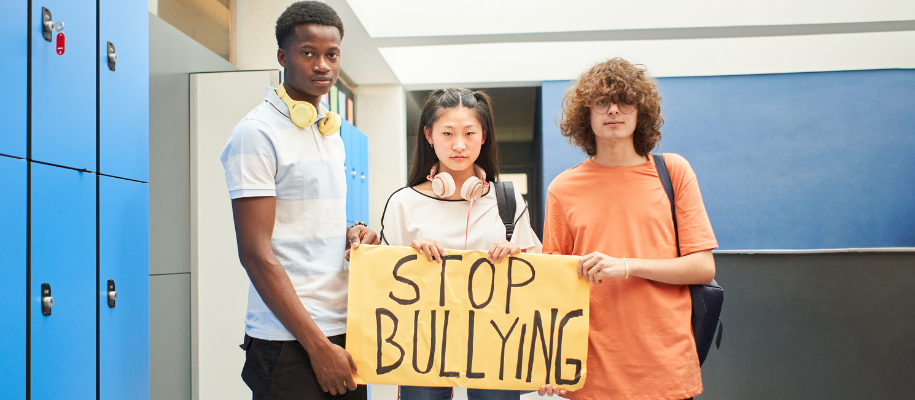Bullying plagues most schools in America and around the world. As a formative time in a teen’s life, high school is rife with insecurities and judgment, both intentional and unintentional. Whether you’ve been bullied, seen someone else being bullied, or reluctantly participated in bullying behavior, there are things you can do to be more aware and combat bullying for yourself and others.
What constitutes bullying?
While most of us are aware of what bullying is, it never hurts to get a refresher on what exactly constitutes as bullying so you know what to look out for, even when it’s minor. According to StopBullying.gov and the first federal definition of the word, bullying consists of three core elements:
- Unwanted aggressive behavior
- Observed or perceived power imbalance
- Repetition or high likelihood of repetition of bullying behaviors
After reading these three simple statements, you may have thought of instances when you’ve witnessed or recognized this behavior. Some things may even come to mind that you wouldn’t think are bullying initially because of how desensitized we’ve become to mean behavior with the internet, constant spread trends, and group social behavior.
How bullying has changed with technology
It’s dangerously easy to take bullying online in a world overridden with technology. Anyone can send life-destroying words in a short text or spread rumors via Instagram stories or popular TikTok trends. According to StopBullying.gov, 15% of students aged 12–18 who reported being bullied during the school year said they were being cyberbullied, either online or by text. While this may make bullying seem inescapable, the lucky thing about phones is the handy “block” option. But even with boundary tools like this, some bullies seem to have enough time on their hands to make fake accounts or find other methods of reaching their victims. So then what can you do?
Related: How Can Students Identify Bullying and Take Action?
What to do if you’re being bullied
School should be a safe place. The internet should be fun. And no one should ever make you feel as though you deserve to be ridiculed or harmed. The hardest thing to do when you’re the victim of bullying is stand up for yourself or ask for help. But these are some of the few surefire ways to put a stop to the situation and protect yourself.
People to seek help from
A common bullying tactic is making victims feel as though they can’t seek help from others—but that’s not true. If someone is bothering you, talk to a friend first to ease the stress of keeping it to yourself. That friend can help you boost your confidence to seek out an adult who can take real action against your aggressor. Consider a parent or guardian, trusted teacher or school counselor, or after-school program mentor. The people in your life want to help you and make sure you’re safe, but they can’t if they don’t know that something is wrong. That’s why it so important to communicate.
Ways to help yourself
While it’s not your fault if you’re being bullied and you shouldn’t have to adjust your life around it, your safety is of the utmost importance. While the situation is being handled and you still share space, find ways to keep busy and surrounded by others. Stick by your friends or, as embarrassing as it may feel, ask a teacher to walk you to your next class if you know you may pass your bully in the hall. Find clubs or activities you love to surround yourself with supportive peers and stay out of the same social circles as your aggressor.
Related: Mental Health: What It Is and How You Can Find Help
What you can do if you’re pressured into bullying behavior
People often think of bullying as one person, but this overlooks its insidious nature and the role peer pressure plays in group bullying behaviors. Bullies often pressure their friends into being mean to others or try to convince others of false information to ostracize their victims. However it’s presented, you don’t have to participate in bullying behavior or stand by silently.
Learning to set boundaries
If you’re friends with someone who spreads rumors about others or makes fun of peers whether they’re around or not, speak up and tell them it makes you uncomfortable when they’re mean. They may think their comments are funny, and hearing your negative reaction could make them hear their own words in a different way. Sure, a lot of bullying scenarios are not this simple—but if your friend has been exhibiting toxic behavior and you nor anyone else have ever expressed displeasure about it, they won’t think it’s a problem with real consequences.
Leaving toxic friendships
Losing friends is hard, but it only gets harder the longer it’s dragged out with animosity. If your friend is participating in bullying behavior and won’t listen to your pleas to stop, leave the friendship. If they can’t be kind to others, what’s stopping them from no longer being nice to you? The best way to take a stand for other people is by not being friends with their bully.
How to combat bullying and help others
Taking a united front against bullying as a school community is the most effective way to prevent it from happening or escalating. People often reference the bystander effect, the phenomenon in which individuals among a group of witnesses all assume someone else will intervene during an emergency and therefore do nothing. While this is still relevant, we have a majorly different understanding of the bystander effect than we used.
Understanding diffusion of responsibility
The psychological concept of diffusion of responsibility helps identify where the bystander effect takes over in an emergency situation. When you witness bullying, you can refer to the five steps of this concept:
- Notice a problem
- Decide if what you’re witnessing is an emergency
- Decide if you should take personal responsibility to act
- Decide what needs to be done
- Take action
Step three is where people often become a bystander instead of an ally. Determining your level of responsibility is often where most individuals find justifications for why they’re not required to act rather than why they should. If it comes down to fear of consequence, there’s more than one way to stand in support of a victim.
Related: Bullying Prevention: How to Beat the Bystander Effect and Be an Ally
Being an ally and speaking up
Standing up for others who can’t stand up for themselves looks different for everyone depending on your comfort level. Whether it’s by defending the person directly during a bully’s attack if you feel safe to do so, being the one to go to an adult for help, or lending an ear and empowering fellow students, there are a lot of ways you can be a support system to those in need.
Understanding but not excusing a bully
Understand the bully? Yes, we know—they hurt and traumatize people. There is no excuse for their behavior. But there may be an explanation for it. Bullying is a complex subject, and it often results from external factors that teachers, peers, or even the bully themselves may not be aware of. In the process of diffusing a harmful situation, it’s important to acknowledge what may have led to the bullying behavior. Understanding behavior and what leads to it helps us all better combat it in the future when we experience it.
Related: How Does Bullying Change From High School to College?
Life is hard, and being part of a bullying problem—or not being part of the solution—is only making moving through this unsteady world more perilous for teens. Stand up for yourself. Stand up for others. You deserve to learn in the safety of a school that values your well-being.
DYK there are scholarship opportunities for students who combat bullying? Not that you need another incentive—but you deserve good things for helping those in need!








